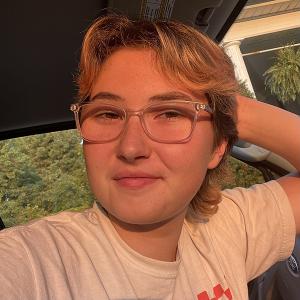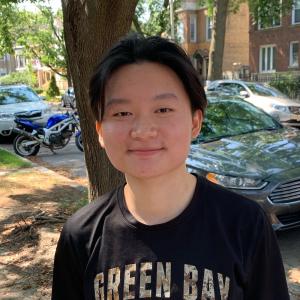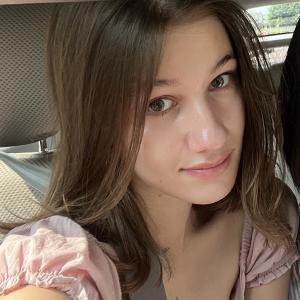Meditation on Ludwig and Liberal Arts
May 19, 2018
Ruth Bieber-Stanley ’21
I sit at gate B10 of the Cleveland Hopkins International Airport. My friend Piper sits next to me. We eat bagels we’ve bought at the Local that morning and chew melancholily before she goes to her gate and we say goodbye for three months. A special about world landmarks plays on the TV screens above, finally taking a much-needed break from the jarring coverage of school shootings and royal weddings. I look up and see the castle the program is featuring. I know it. In fact, I have been there: Neuschwanstein Castle in Germany, the Romanesque revival spectacle that inspired the Sleeping Beauty Castle in Disneyland. The number of times King Ludwig has come up this semester is frankly ridiculous. The Fairy Tale King is following me. Dedicated readers may even remember allusions to him earlier in my blog publications. For those who aren’t intimately familiar with 19th-century Bavarian kings, a brief history lesson:
King Ludwig II was a misanthropic and eccentric king of Bavaria in the mid-19th century who is known for his construction of ornate and lavish castles across Germany, most notably Linderhof, Herrenchiemsee, and of course, Neuschwanstein. A friend of Richard Wagner’s and a patron of the arts, Ludwig never really identified with other people and preferred to ensconce himself in a fantasy world of his own creation. His castles were his refuges: he escaped to them to avoid human contact and when the world became too much. Ludwig died under mysterious circumstances. After leaving Bavaria in a bit of an economic mess after depleting the kingdom’s funds to build his palaces, he was declared insane by his cabinet. He was deposed, and, mere days after his deposition, was found dead, drowned in a lake. The cause of death remains a mystery.
So now you know about Ludwig. His story doesn’t seem like it would be particularly pervasive in anyone’s education, except perhaps if you were studying 19th-century German history and politics, or maybe Romanesque revival architecture. It may be surprising, therefore, when I say that the Fairy Tale King came up in multiple capacities this semester in my academic life.
In the first half of my German 102 class, we had to do a five-minute oral presentation in German on a topic of our choosing. I decided to present on Ludwig, since his story is particularly interesting, and can be summarized briefly in five minutes of spoken German. In my research of the king, I learned that he was a good friend of Richard Wagner, a 19th-century opera composer. Thus began a rather odd chain of events of connections across disciplines. We had learned about Richard Wagner in my Arthurian Fictions class. Wagner employed Arthurian traditions throughout his work: in his Tristan und Isolde opera, based on Gottfried von Strassburg’s “Tristan,” and Parsifal, loosely inspired by Wolfram von Eschenbach’s 12th-century “Parzifal,” an operatic Grail narrative including a Percival figure (this might sound like jargon to anyone who didn’t spend an entire semester talking about Arthurian media, sorry about that).
The Ludwig connections continued to develop in my Arthurian fiction class. When I had to do a presentation on a 19th-century Arthurian artifact, I was at a loss. But then I remembered that somewhere I had read that Ludwig had commissioned Arthurian murals and frescoes all over Neuschwanstein. I found one, a scene from Wagner’s Parsifal opera. I related the piece of art to Ludwig’s childhood, pointing out the parallels between Ludwig’s and Percival’s stories, and spoke about the larger Arthurian tradition as a body capable of transcending historical and cultural boundaries.
But wait—there’s more! In reading T.S. Eliot’s poem The Waste Land, a commentary on modernity and rebirth replete with specific literary, cultural, and artistic allusions, which I also read for Arthurian Fictions, I could see other connections to Ludwig. Water imagery is used heavily throughout Eliot’s piece: he references several drowned literary figures, and quotes Ariel’s “sea change” passage from Shakespeare’s The Tempest frequently. Not only was I reminded of Ludwig’s watery death, but Eliot even mentions visiting Starnbergersee as a child, the lake where Ludwig’s body was found. The king will not leave me alone! It seems only fitting that in my Arthurian Fictions final I took two nights ago, I name-dropped him in a short essay about the ubiquity of water as a symbol of rebirth in Arthurian traditions (Prof. Bryan, if you’re reading this, I hope you like it!).
By now you might be wondering where I’m going with this. I promise, there’s a point. This year, I took nine classes in eight different academic departments: First-Year Seminar Program (history), Dance, German, Chemistry, Math (stats), English, Creative Writing, and Psychology. I am fortunate in that I came from a high school that sometimes employed deliberate curriculum crossover. That is, content in my English classes would relate to my history classes, and my language classes, and so on. This year, despite having taken a wide variety of courses in a wide variety of disciplines, I managed to draw connections between what I had studied. Here are a few more examples of this:
In Arthurian Fictions, we read an excerpt of an Ursula Le Guin essay on fantasy in child literature and psychology, particularly Jungian psychology. While my Intro Psych course didn’t focus heavily on Freudian or Jungian psych, I definitely got a handle on their basic philosophies, and had learned a fair amount about introspection, an early psychological framework based on the individual looking within to understand their subjective experiences. With this understanding of introspection, I was able to write a reading journal about the connections between reading fantasy novels, Jungian psychology, cognitive development, and education narratives in the Arthurian tradition. Later in psychology class, I read an article for extra credit about how humans process metaphor, particularly unconsciously, and how using metaphorical reasoning in real life can affect serious things like the development of crime policy. It was a new way to understand metaphor, completely separate from how we’d talked about it in my Intro Creative Writing class. When learning about language acquisition in psych, I started to think more about languages, something I already love, in a different context. Psych concepts started to transfer to every area of my life, even outside my academic classes (you’d be surprised about how much watching Jane the Virgin on Netflix made me think about operant conditioning!). Even after just one Intro Psych class, I am already starting to think of the world and other people in new ways.
But the connections weren’t limited to this semester! Towards the end of my psych lectures, we learned a lot about concepts very related to the field of statistics. To any prospective students: you may have seen me complain about stats on this blog. It is hard. But if I were to recommend ANY class that you should absolutely take at some point in your college career, it would be stats. Trust me on this. Having a good understanding of stats enabled me to grasp the psych lecture content much more quickly, and I even found what could have been a fairly dry lecture interesting (I know, GASP!). Honestly, understanding material and being able to apply new knowledge to things you’ve seen before and vice versa is a thrilling process!
Connecting the dots between my very different classes this semester was incredibly exciting for me. I’ll give you a concrete example: in one FaceTime call to my family, I ended up geeking out about psych studies related to language acquisition for a good twenty minutes. Forming connections between different classes this semester resulted in much fuller and richer academic engagement and exploration. In ways that I never have before, I feel that I am capable of relating and forming associations between different or only tangentially related things. Or maybe they are related, but I can just see it better now. And that’s an exciting place to be, especially now that I am narrowing my path to distinct disciplines. Specialization lies in my future, and once you enter a field, it’s helpful to be able to draw from a vast swath of knowledge. I want to be the person that thinks of things other people don’t!
This morning I took my last final, and now I’m sitting on an airplane on the way home, writing this post. I’m officially done with my first year of college, which is wild. I am curious to see how going home feels, and discover how I’ve changed. I like to think that as a result of my liberal arts education, I have further developed my critical thinking skills and creativity (as cliché as that sounds). A hallmark of the liberal arts is that they teach students to be quick thinkers who are good at assimilating knowledge and building off of it rapidly, applying skills they learn in one area to another. I certainly feel like, in many small ways, that is beginning to happen to me. Then again, it could just be the ghost of a Bavarian king haunting me. I guess I’ll just have to wait and see :)
Similar Blog Entries

Poetry
April 25, 2024

